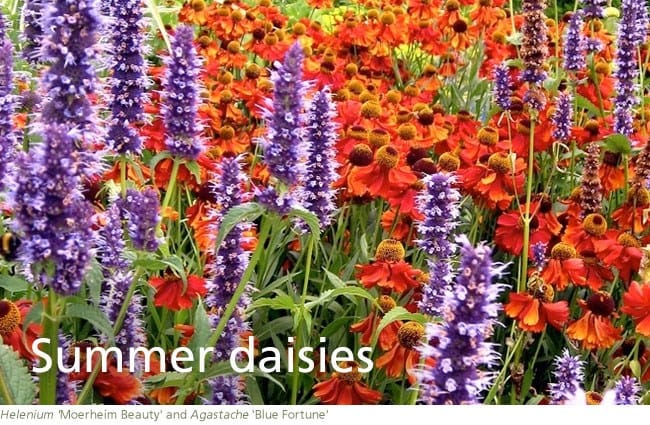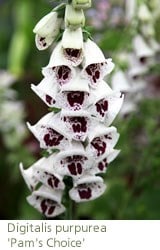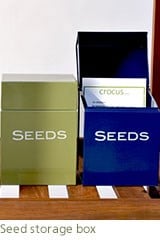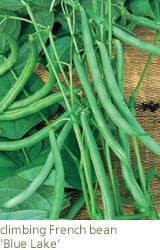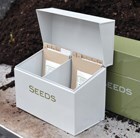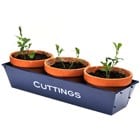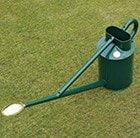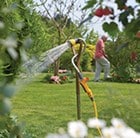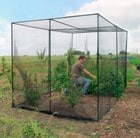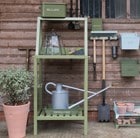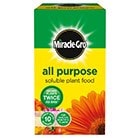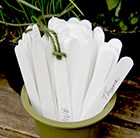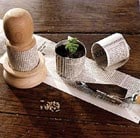|
Sun Lovers
The name daisy is a corruption of ‘day’s eye’ and the golden rule is that almost every daisy in the world loves to bask in bright sun rather than shade. Many prostrate themselves to face heavenward, as the resplendent echinacea does others, like the sunflower, chase the sun by turning their vertical flowers and moving round like the hands of a clock as the day progresses. These head turners need careful placing, otherwise you might only see their backs!
Golden Threads
Yellow daisies can dominate August a little too much, but careful positioning will create a golden thread that runs through the garden tapestry. The secret is to balance your colour wheel by adding purples and blues.
Pallid Yellows
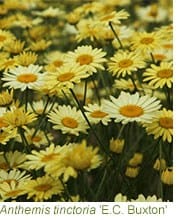 Most summer-flowering daisies tend to be golden yellow, but there are purer lemons on the cooler side. Anthemis ‘E.C. Buxton’ is a clear-yellow that’s as pure as freshly gathered lemons from Morocco. This sun lover, roughly up to 70 cm high, was found in the Welsh garden of E.C. Buxton in 1910. It bears larger flowers than most, held on wiry stems that rise above deep-green feathery foliage. Like all anthemis it prefers free-draining soil and has a short-lived tendency. Don’t let that put you off though. The solution is simple. In early summer pull a couple of pieces away and they will almost certainly have some roots attached. These ‘Irishmen’s cuttings’ will root easily and can be planted out in early September. Or replace your plants every three years. Most summer-flowering daisies tend to be golden yellow, but there are purer lemons on the cooler side. Anthemis ‘E.C. Buxton’ is a clear-yellow that’s as pure as freshly gathered lemons from Morocco. This sun lover, roughly up to 70 cm high, was found in the Welsh garden of E.C. Buxton in 1910. It bears larger flowers than most, held on wiry stems that rise above deep-green feathery foliage. Like all anthemis it prefers free-draining soil and has a short-lived tendency. Don’t let that put you off though. The solution is simple. In early summer pull a couple of pieces away and they will almost certainly have some roots attached. These ‘Irishmen’s cuttings’ will root easily and can be planted out in early September. Or replace your plants every three years.
Equally pallid is the tall Helianthus ‘Lemon Queen’ and Her Majesty is in the top flight of daisies. This is another oldie, bred in the 1920s by Thomas Carlile of the Loddon Nursery. This Berkshire nursery used to stop the traffic on the Twyford Bypass with massed plantings on Tommy’s Corner, as it was called. Although many of his daisies have the Loddon prefix, this man-high tight clump-former was named ‘Lemon Queen’. It’s freestanding and the single lemon-yellow flowers have black-flecked middles from mid-August onwards. It’s the perfect partner for the cloud-headed, sultry reddish purple heads of Eupatorium maculatum (Atropurpureum Group) 'Riesenschirm'. This refined form with darker stems sets off the lemon daisies that angle themselves vertically and chase the sun. A south or west-facing border is ideal, not north. Or you could use the purple ironweed, Vernonia arkansana ‘Mammuth’, for its tight mophead of flowers. Like the eupatorium, it’s also a daisy without the petals so still insect friendly.
More Dark Stems
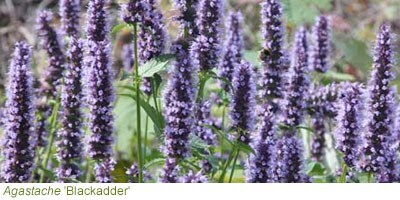
Dark stems are an added bonus and they feature strongly in Heliopsis helianthoides var. scabra 'Summer Nights'. This flowers earlier than most daisies, by early July, but keeps going. The wiry black stems, which reach 1.2m, branch at the top and support clusters of small single daisies of golden yellow. Each has short, wide ray petals surrounding a large domed red middle, so this is an eye-catching plant in every respect. Grown close to Agastache ‘Blackadder’, another black-stemmed perennial with deep-blue bee-friendly spires, it shines.
 Or if you’ve a quieter place, close to box balls for instance, the meandering, floppy dark stems and green-diamond foliage of Aster divaricatus look superb. Tiny white flowers follow in August and then heather-pink thistly heads appear, but it's principally grown for those seductive ebony stems. Or if you’ve a quieter place, close to box balls for instance, the meandering, floppy dark stems and green-diamond foliage of Aster divaricatus look superb. Tiny white flowers follow in August and then heather-pink thistly heads appear, but it's principally grown for those seductive ebony stems.
Rich Mahogany Middles
Daisy middles come in many guises, but the heleniums or sneezeweeds, have brown velvet centres that fluff up as the pollinators get busy. The flowers come in shades of yellow, to orange, to mahogany-red and, if you have good soil, this is one of the best August performers of all. Heights vary from the short border edgers to the taller back of border varieties. Generally though the shorter ones flower first and the taller ones can be as late as September, often with fiery flowers.
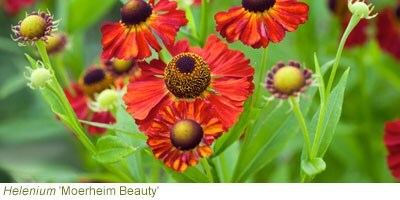
The classic ‘Moerheim Beauty’ (1930) has grace and elegance because it’s mahogany-red flowers have a double layer of ragged-edged petals that droop down before flouncing upwards. It’s among the earliest of all, with a very dark centre, and makes the perfect partner for Agastache ‘Blue Fortune’, a mid-blue bottlebrush flower with aromatic foliage.
‘Potter’s Wheel’ is a shorter helenium, roughly 60cm in height, with a single circle of splayed out deep crimson-brown petals edged in gold. It’s very disc-like and simple, an Audrey Hepburn of the garden. 'Ruby Thuesday' is equally short with dark-red flowers that appear almost black at first. As they open the petals become quilled.
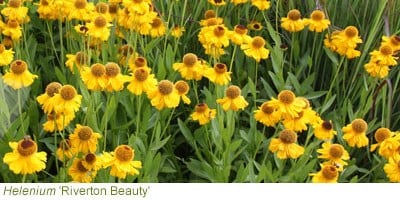
Taller heleniums include 'Rauchtopas', German for smoky topaz, the apricot petals are streaked in red on the undersides and as the petals curl upwards (in a very loose arrangement) there’s a bicolour effect of apricot and terracotta on this 1.2m high stunner. 'Riverton Beauty' is a similar height, but a sunny bright yellow with dark velvet centred middles.
Rudbeckias
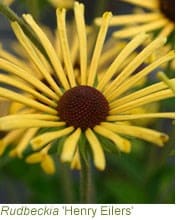 If you enjoy quilled petals, Rudbeckia subtomentosa 'Henry Eilers' is a very durable, easy to grow upright plant with small flowers consisting of almost tubular petals set round a small chestnut-brown middle. It was found growing in the wild, among ordinary rayed daisies, in a railroad prairie in Montgomery County, Illinois by a sharp-eyed local nurseryman of the same name. It was introduced in 2003 and soon became highly popular. If you enjoy quilled petals, Rudbeckia subtomentosa 'Henry Eilers' is a very durable, easy to grow upright plant with small flowers consisting of almost tubular petals set round a small chestnut-brown middle. It was found growing in the wild, among ordinary rayed daisies, in a railroad prairie in Montgomery County, Illinois by a sharp-eyed local nurseryman of the same name. It was introduced in 2003 and soon became highly popular.
R. triloba is another North American native, but from the central eastern United States, and the three-lobed leaves reflect its name. It forms a bushy plant that's covered in small yellow daisies with crisp dark-brown middles, so this is show stopping when in full flow. The flowers last well into autumn, but this plant often flowers itself to death and rarely lasts more than three or four years. Once you’ve got it, you never want to be without it though.

The classic, perennial yellow daisy is Rudbeckia fulgida var. sullivantii 'Goldsturm'. This golden yellow daisy flowers from August until October, with golden yellow petals beautifully arranged round a central dark-brown disc. This superb plant, the best rudbeckia of all, was discovered by another sharp-eyed nurseryman, Heinrich Hagemann, in 1937 in the Czech Republic. Hagemann convinced his employer Karl Foerster of Potsdam, Germany to propagate his discovery. However the 'Goldsturm', which translates as Gold Storm, was not released until 1949.
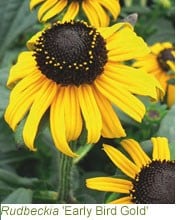 If you’ve a smaller garden try Rudbeckia fulgida 'Early Bird Gold' (PBR), a hybrid from ‘Goldsturm’ discovered by a grower in Plaquemine, Louisiana. He noticed that it flowered two months earlier, beginning in June. If you’ve a smaller garden try Rudbeckia fulgida 'Early Bird Gold' (PBR), a hybrid from ‘Goldsturm’ discovered by a grower in Plaquemine, Louisiana. He noticed that it flowered two months earlier, beginning in June.
Echinaceas
Echinaceas make August very special, with their strong-stemmed large daisy flowers. In their native America they thrive on very cold winters and hot summers, so hardiness is not a problem. However warm winters can cause problems, because they start into growth precociously. The easiest to grow are the seed-raised strains such E. purpurea ‘Magnus ’ or ‘ White Swan’. These can be grown with the dark-leaved Sedum telephium (Atropurpureum Group) 'Purple Emperor' with the grassy fluffy caterpillars of Pennisetum alopecuroides 'Hameln'. Their almost golden middles make them highly useful in the garden because they seem to mix with anything.
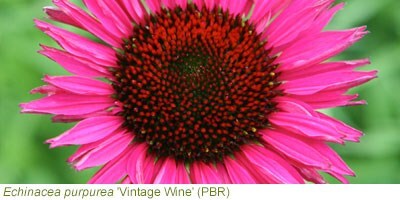
The vibrant red-pink ‘Vintage Wine’ has an enormous central disc and short-ray petals. The green and pink ‘Green Envy’ has petals that fade from pink to green and this is superb used with the lacy green leaves of Selinum wallichianum, a handsome August-flowering white umbellifer with mauve sheathing. Or try the fragrant short pink 'Kim's Knee High', with its many stems of smaller daisies.
Asters
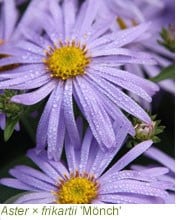 Asters are also under way and the earliest is always Aster × frikartii 'Mönch', with long-rayed lavender daisies that begin in July. It’s drought tolerant and easy, being bred from two European species by Mr Frikart. It makes an excellent partner for Rudbeckia fulgida var. sullivantii' Goldsturm', but it isn’t stiff stemmed, so place it near the front of the border so it can loll a little. That's the position it likes. Asters are also under way and the earliest is always Aster × frikartii 'Mönch', with long-rayed lavender daisies that begin in July. It’s drought tolerant and easy, being bred from two European species by Mr Frikart. It makes an excellent partner for Rudbeckia fulgida var. sullivantii' Goldsturm', but it isn’t stiff stemmed, so place it near the front of the border so it can loll a little. That's the position it likes.
Always find a place for ‘Little Carlow’, a small-flowered lavender aster that takes on a blue hue as the days shorten. It’s bushy with fine foliage and red-scaled buds, so it’s an attractive plant long before it flowers. The flowers cover ‘Little Carlow’, but New England asters (Aster novae-angliae) tend to have flower at the top and rather unsightly woody stems below. Position ‘Harrington’s Pink’ behind other plants and then watch as the butterflies descend in late-August and September because these are the most butterfly-pleasing asters of all. They generally come in various shades of pink, mauve and white.
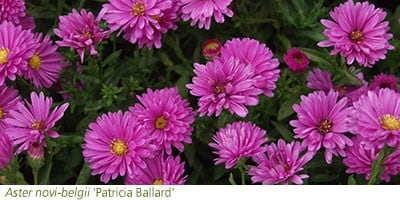
New York asters (A. novi-belgii) tend to be more demanding, because they need a lot of moisture at the root. However ‘Purple Dome’ is a compact aster, perfect for the front of border, that grows strongly. It's a perfect landing pad for small tortoiseshell butterflies!
|
Five things to do
|



